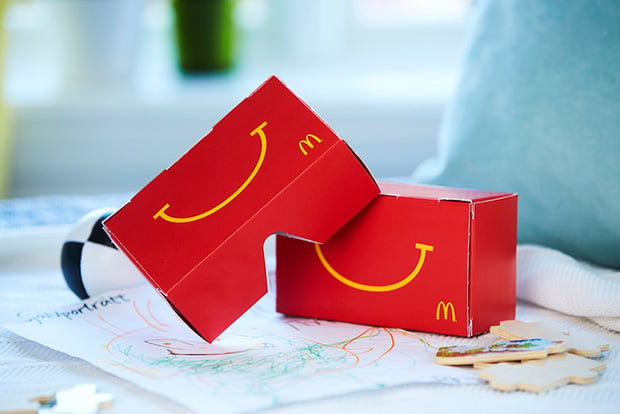McDonalds Serves VR Experience In A Happy Meal Box With 'Happy Goggles'
Virtual reality has captured the hearts and imaginations of consumers and developers alike. In keeping with modern times, even McDonald's is hitching a ride on the hype train with a VR solution of its own. It's the Happy Meal box, which customers can fold up into a set of virtual reality glasses similar to Google Cardboard.
McDonald's Sweden is piloting the VR initiative. The fast food chain came up with the idea in conjunction with licensed child psychologists Karl Eder and Fadi Lahdo, who believe that the creation of Happy Goggles can be a learning opportunity for kids and adults alike, one that even brings them together.

"New generations are growing up in a in a world where smartphones and tablets are a part of our ordinary life. The VR goggles open the door to virtual worlds, which of course is very exciting," says Eder and Lahdo. "This step might come more natural for children than for adults. It creates an opportunity for adults to learn from the children’s knowledge and experience. The gaming can also be a good, joint activity that makes it easier to hang out - on equal terms."
The picture McDonald's Sweden paints in its press release is that of children being more in tune with technology than their parents, and Happy Goggles being a tool to help bridge that gap. Maybe that's overthinking things or maybe it isn't—either way, McDonald's has found a new way to promote its Happy Meal to a new generation of kids.
Happy Goggles is similar to Google Cardboard in that it's a cheap headset you use with your phone. In this case, you unfold the Happy Meal box and tear along the perforated edges. You then fold the remaining part of the box, slide the included lens kit inside, and insert your smartphone.
Patrons can test the contraption out with a free VR skiing game called Slope Stars that will be available to download from McDonald's Sweden's website.
This isn't going to transform the VR experience like Oculus Rift and HTC Vive are positioned to do. However, it is a fun marketing gimmick that doesn't try to fight the idea that this generation's youth is completely absorbed by their mobile devices. It's also a continuation of the chain's desire to utilize the latest technologies, like 3D printing and touchscreens.
McDonald's Sweden is piloting the VR initiative. The fast food chain came up with the idea in conjunction with licensed child psychologists Karl Eder and Fadi Lahdo, who believe that the creation of Happy Goggles can be a learning opportunity for kids and adults alike, one that even brings them together.

"New generations are growing up in a in a world where smartphones and tablets are a part of our ordinary life. The VR goggles open the door to virtual worlds, which of course is very exciting," says Eder and Lahdo. "This step might come more natural for children than for adults. It creates an opportunity for adults to learn from the children’s knowledge and experience. The gaming can also be a good, joint activity that makes it easier to hang out - on equal terms."
The picture McDonald's Sweden paints in its press release is that of children being more in tune with technology than their parents, and Happy Goggles being a tool to help bridge that gap. Maybe that's overthinking things or maybe it isn't—either way, McDonald's has found a new way to promote its Happy Meal to a new generation of kids.
Happy Goggles is similar to Google Cardboard in that it's a cheap headset you use with your phone. In this case, you unfold the Happy Meal box and tear along the perforated edges. You then fold the remaining part of the box, slide the included lens kit inside, and insert your smartphone.
Patrons can test the contraption out with a free VR skiing game called Slope Stars that will be available to download from McDonald's Sweden's website.
This isn't going to transform the VR experience like Oculus Rift and HTC Vive are positioned to do. However, it is a fun marketing gimmick that doesn't try to fight the idea that this generation's youth is completely absorbed by their mobile devices. It's also a continuation of the chain's desire to utilize the latest technologies, like 3D printing and touchscreens.

